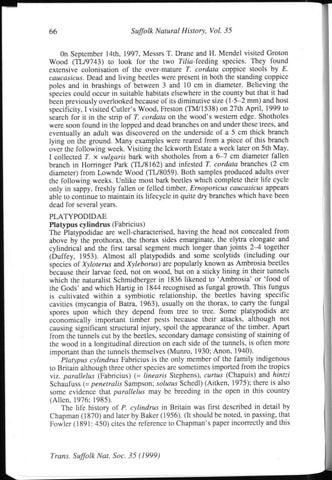66
Suffolk Natural History, Vol. 35
On September 14th, 1997, Messrs T. Dräne and H. Mendel visited Groton Wood (TL/9743) to look for the two Tilia-feeding species. They found extensive colonisation of the over-mature T. cordata coppice stools by E. caucasicus. Dead and living beetles were present in both the Standing coppice poles and in brashings of between 3 and 10 cm in diameter. Believing the species could occur in suitable habitats elsewhere in the county but that it had been previously overlooked because of its diminutive size (1-5—2 mm) and host specificity, I visited Cutler's Wood, Freston (TM/1538) on 27th April, 1999 to search for it in the Strip of T. cordata on the wood's western edge. Shotholes were soon found in the lopped and dead branches on and under these trees, and eventually an adult was discovered on the underside of a 5 cm thick branch lying on the ground. Many examples were reared from a piece of this branch over the following week. Visiting the Ickworth Estate a week later on 5th May, I collected T. x vulgaris bark with shotholes from a 6 - 7 cm diameter fallen branch in Horringer Park (TL/8162) and infested T. cordata branches (2 cm diameter) from Lownde Wood (TL/8059). Both samples produced adults over the following weeks. Unlike most bark beetles which complete their life cycle only in sappy, freshly fallen or felled timber, Ernoporicus caucasicus appears able to continue to maintain its lifecycle in quite dry branches which have been dead for several years. PLATYPODIDAE Piatypus cylindrus (Fabricius) The Platypodidae are well-characterised, having the head not concealed from above by the prothorax, the thorax sides emarginate, the elytra elongate and cylindrical and the first larsal segment much longer than joints 2-4 together (Duffey, 1953). Almost all platypodids and some scolytids (including our species of Xyloterus and Xyleborus) are popularly known as Ambrosia beetles because their larvae feed, not on wood, but on a sticky lining in their tunnels which the naturalist Schmidberger in 1836 likened to 'Ambrosia' or 'food of the Gods' and which Hartig in 1844 recognised as fungal growth. This fungus is cultivated within a symbiotic relationship, the beetles having specific cavities (myeangia of Batra, 1963), usually on the thorax, to carry the fungal spores upon which they depend from tree to tree. Some platypodids are economically important timber pests because their attacks, although not causing significant structural injury, spoil the appearance of the timber. Apart from the tunnels cut by the beetles, secondary damage consisting of staining of the wood in a longitudinal direction on each side of the tunnels, is often more important than the tunnels themselves (Munro, 1930; Anon, 1940). Piatypus cylindrus Fabricius is the only member of the family indigenous to Britain although three other species are sometimes imported from the tropics viz. parallelus (Fabricius) (= linearis Stephens), curtus (Chapuis) and hintzi Schaufuss (= penetralis Sampson; solutus Schedl) (Aitken, 1975); there is also some evidence that parallelus may be breeding in the open in this country (Allen, 1976; 1985). The life history of P. cylindrus in Britain was first described in detail by Chapman (1870) and later by Baker (1956). (It should be noted, in passing, that Fowler (1891: 450) cites the reference to Chapman's paper incorrectly and this
Trans. Suffolk Nat. Soc. 35
(1999)
